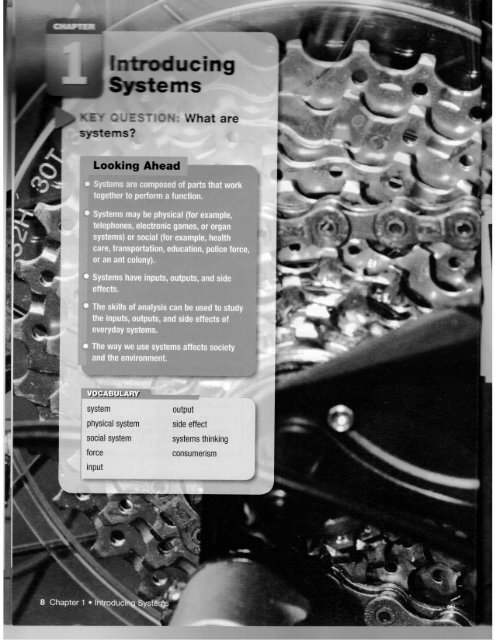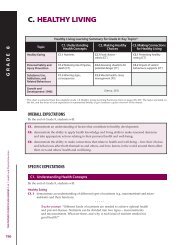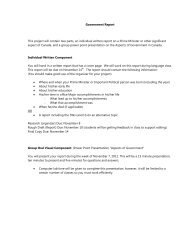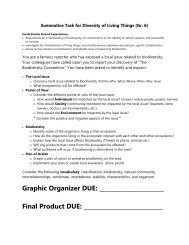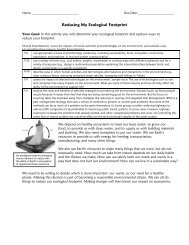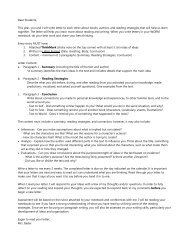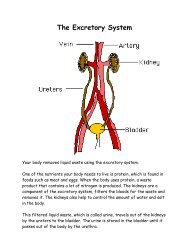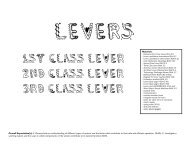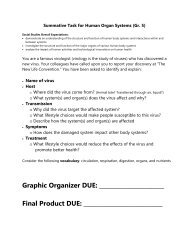Types of Systems
Types of Systems
Types of Systems
You also want an ePaper? Increase the reach of your titles
YUMPU automatically turns print PDFs into web optimized ePapers that Google loves.
ems?<br />
Looking Ahead<br />
social system<br />
force<br />
input<br />
output<br />
side effect<br />
systems thinking<br />
consumerism
Science and Technology<br />
More Than Meets the Eye<br />
Pictures always tell a bigger story than seems to be the<br />
case at first glance. Like the BMX race that Zara and<br />
Ryan observed, the objects and scenes shown here are<br />
not unique or isolated; they contain smaller parts that<br />
work together and are connected to other things in<br />
their environment.<br />
LINKING TO<br />
Cameras are used t o take pictures.<br />
Inferring from Pictures<br />
When we read, we use clues from the text and figures to determine<br />
or "infer" information that is not directly stated. Sometimes the<br />
information we get from figures helps us more clearly understand<br />
what we are reading.<br />
D Analyze each picture by asking yourself, "What is the main<br />
purpose <strong>of</strong> the object or scene illustrated in the picture? What<br />
smaller components does the object or scene contain that helps<br />
it fulfill its purpose? What connections may there be between<br />
the object or scene and other objects (including people) in its<br />
environment?" Record your thoughts in point form . Discuss your<br />
ideas with a partner.<br />
Excavators are large machines<br />
that do a lot <strong>of</strong> work.<br />
Blue boxes are used t o help reduce<br />
the amount <strong>of</strong> garbage in landfills.<br />
. kl and<br />
Ambulances are used to qUic Y . k<br />
safely transport people who are SIC<br />
or injured.<br />
9
Table 2 Some Ojibwe Clans and Their Traditional Roles<br />
Clan<br />
Crane and Loon<br />
Fish<br />
Bear<br />
Ho<strong>of</strong><br />
Marten<br />
Bird<br />
Ojibwe name<br />
Ajejauk (Crane)<br />
Giigo<br />
Makwa<br />
Waawaashkeshi (Deer),<br />
Adik (Caribou)<br />
Waabizheshi<br />
Maang<br />
Table 2 lists some <strong>of</strong> the common Ojibwe clans. Clan systems are used<br />
as a form <strong>of</strong> government and as a way <strong>of</strong> determining the tasks that<br />
people in the clan perform.<br />
--+-<br />
1. Give two examples <strong>of</strong> each <strong>of</strong> the following systems:<br />
(a) mechanical system<br />
(b) optical system<br />
(c) hydraulic system<br />
(d) electrical system<br />
2. What do physical systems and social systems have in<br />
common? How are they different?<br />
· 2 C aD er - In roducing <strong>Systems</strong><br />
Role/occupation<br />
e: share chieftainship<br />
conduct communication with outsiders<br />
I assist with communication within the band<br />
- teachers and scholars<br />
- help settle arguments between the leaders <strong>of</strong> the Crane and Loon clan<br />
- police and guardians<br />
- have knowledge <strong>of</strong> the environment and learn <strong>of</strong> natural medicines available in<br />
the environment<br />
- gentle caregivers<br />
- look after housing and recreation<br />
- hunters, gatherers, and warriors<br />
- spiritual leaders<br />
Communities are traditionally governed by a band council made<br />
up <strong>of</strong> leaders from the various clans. The clan system also governs<br />
relations between tribes and helps provide guidance about marriages.<br />
In the Ojibwe Nation, clans are passed down the generations through<br />
the male family line. The Mohawk clans follow the mother's bloodline.<br />
Clan Mothers choose chiefs, raise leaders, record names, and advise<br />
partnerships. The clan continues to be an important element <strong>of</strong> First<br />
• Nations identity.<br />
3. Give two examples <strong>of</strong> each <strong>of</strong> the following :<br />
(a) physical systems designed by people<br />
(b) naturally occurring physical systems<br />
(c) social systems that you are a part <strong>of</strong><br />
(d) naturally occurring social systems<br />
4. Why are Aboriginal clan systems considered human social<br />
systems?<br />
NEL


